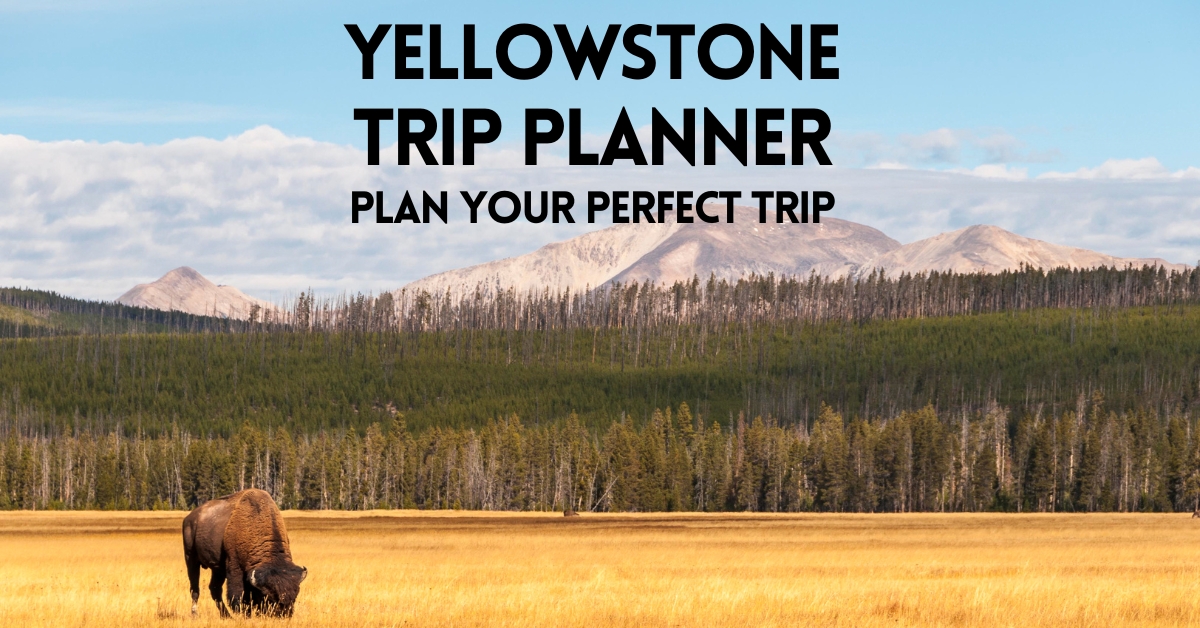Yellowstone Trip Planner – Visitors Guide For Your Perfect Trip
Introducing Yellowstone National Park
Welcome to our Yellowstone National Park trip planner! This majestic park is an iconic American landmark in Wyoming, Montana, and Idaho. Established in 1872, it is the oldest national park in the US and offers a breathtaking array of wildlife and stunning scenery to explore. Yellowstone is also the world’s first national park. Boasting its unique geothermal features like hot springs, mud pots, geysers, and fumaroles, it’s a nature lover’s paradise. From alpine meadows to deep canyons and pristine mountain lakes, there’s something for everyone here in Yellowstone National Park.
We’ll explore what you should plan when taking a trip to Yellowstone and all the best spots you won’t want to miss!
The Places Where We Go contains affiliate links and is a member of the Amazon Services LLC Associates Program. As an Amazon Associate, we earn from qualifying purchases at no extra cost to you when you purchase using one of these Amazon links. Read our disclaimer and privacy policy for more information.
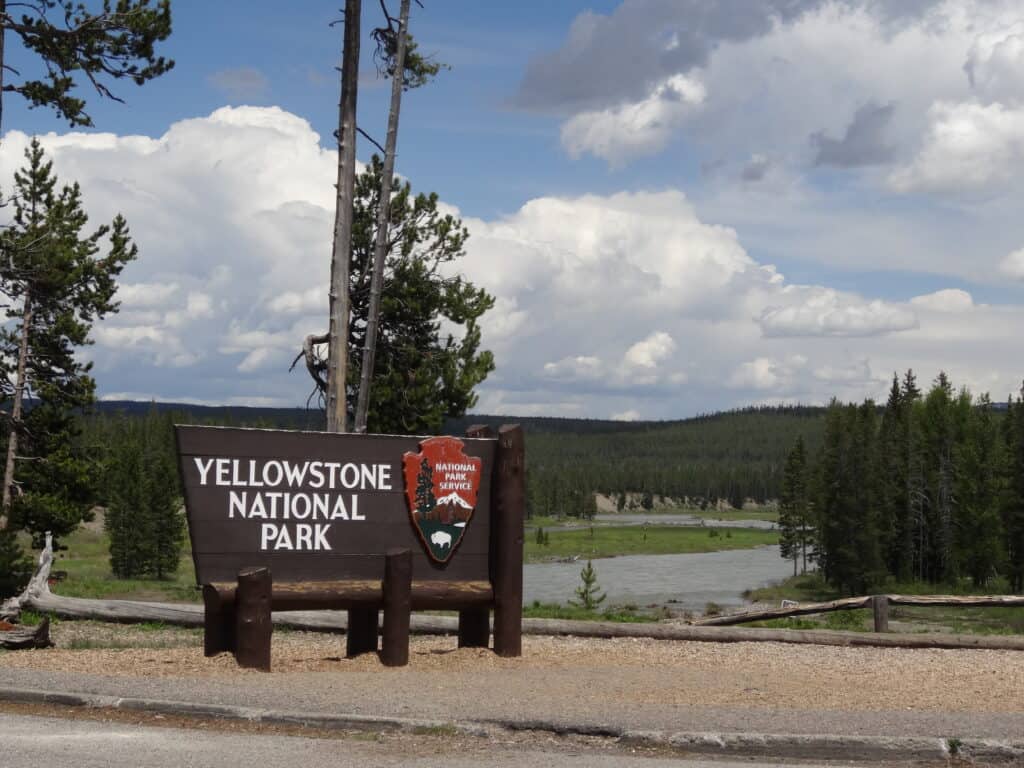
Yellowstone Trip Planner
The Best Time To Visit Yellowstone
The best time to visit Yellowstone National Park is late April through early October. These months offer the most pleasant weather in the park, with average temperatures ranging from 45-80 °F. This period also provides access to all of the park’s main attractions, including popular geyser basins such as Old Faithful, Mammoth Hot Springs, and the Norris Geyser Basin.
While you may be able to find solitude in the backcountry of Yellowstone during the winter months, most attractions are closed due to unsafe weather conditions. So, if you’re looking to explore this incredible park, plan your visit between late April and early October for a safe and enjoyable experience.
If you want to avoid crowds and still enjoy the best of Yellowstone, your best bet is to visit either in May or from September through October.
Let’s get into our Yellowstone Trip Planner by taking a look at the experience in the park by season of the year.
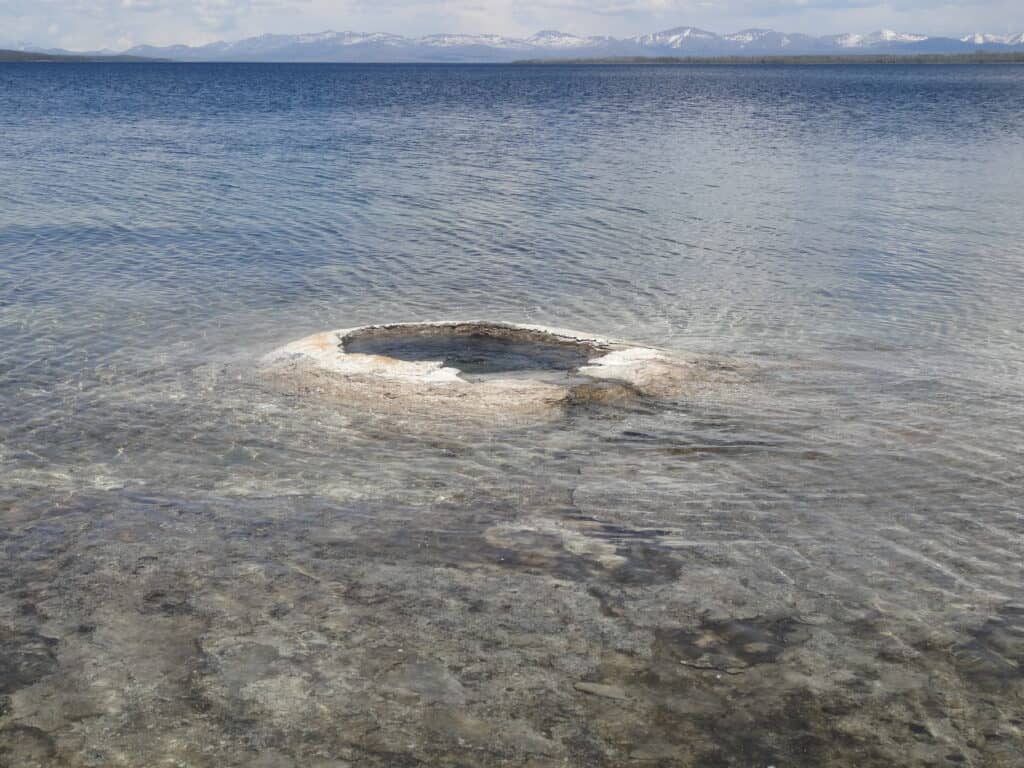
Yellowstone in Spring
Pros:
- The park is less crowded – averaging less than 1,500 visitors per day.
- It is an excellent time to view bears. The park is home to grizzly bears and black bears.
Cons:
- Weather – You’ll experience cold temperatures during much of the Spring season—daytime highs average in the 40s, and it’s common for overnight temperatures to dip below freezing.
- Amenities – Many park amenities are not available during the spring season.
- Transportation – Park roads are likely closed, so you’ll want to check road conditions before your spring arrival.
Yellowstone in Summer
Pros:
- Amenities – Aside from closures for maintenance, you’ll likely have access to all park amenities during summer, including hiking trail access.
- Weather – The best temperature for Yellowstone is during the summer months, with daytime temperatures averaging in the 70s. Nights can still be cold, dropping into the 30s.
Cons:
- Crowds – Summer is the high season and most popular time with visitors in Yellowstone. You can still beat the crowds if you visit the top attractions very early in the day or later in the evening.
Yellowstone in Fall
Pros:
- Crowds – The peak season summer crowds dissipate once kids return to school, so there are fewer issues with busy roads and parking lots in the fall.
- Weather – Daytime temperatures are generally pleasant, averaging in the 50s and 60s.
- Wildlife Viewing – Fall provides an excellent time to view bears and elk.
Cons:
- Amenities and Roads begin to close later in the fall season.
Yellowstone in Winter
Pros:
- Experience – If you are up to booking a snow coach tour or snowmobile, you can enjoy a unique park perspective during the winter months.
- Wildlife – Winter is a great time to spot wolves in the park.
Cons:
- Access to attractions – Much of the park is difficult to visit with road closures. Certain attractions like Old Faithful are only accessible by snowmobile.
- Weather – Temperatures can be very harsh, with freezing cold and heavy snow limiting access and travel in the park.
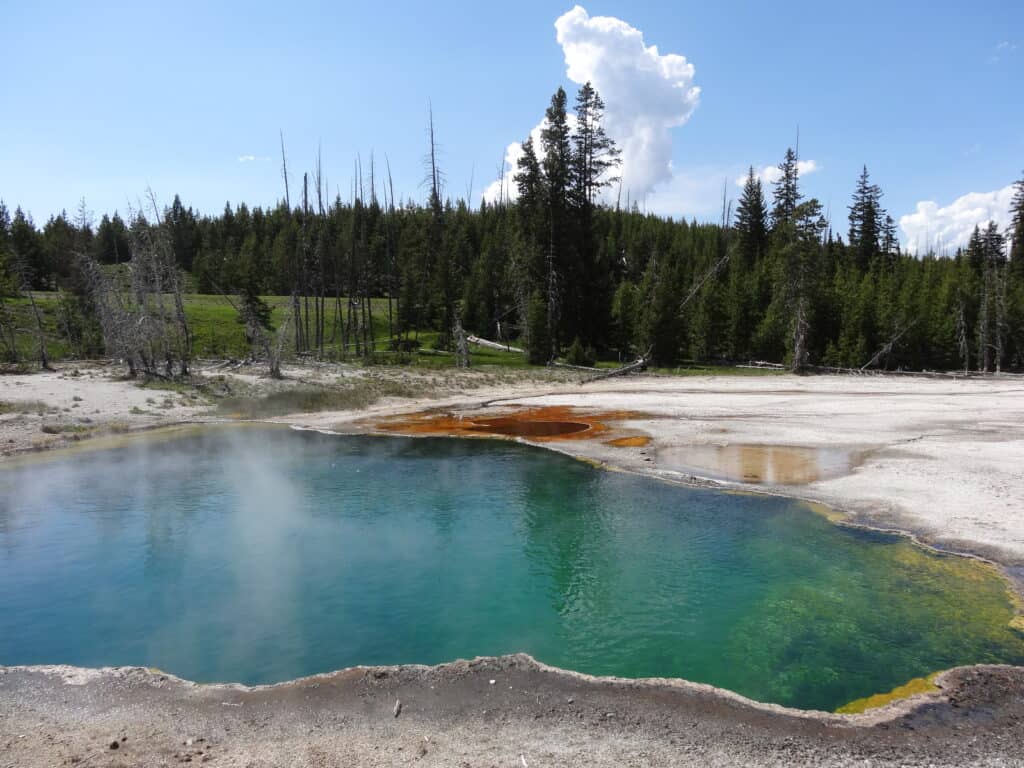
Yellowstone Trip Planner
Park Entrances in Yellowstone
There are five entrances to Yellowstone National Park, providing access to the various regions of the park. The entrances are connected via the Grand Loop Road. Access to the park is provided by two entries on the north side and one each on the park’s west, south, and east sides, respectively. These access points make it relatively easy for cars coming in from various parts of the country for their Yellowstone visit.
North Entrance – Gardiner, Montana
The North Entrance is the only entrance open all year-round. This is your best access to Mammoth Hot Springs. For airport access closest to this entrance, consider Bozeman Airport.
Northeast Entrance – Cooke City, Montana
This is your best access point for traveling to Lamar Valley and driving on the Beartooth Highway. Consider the Billings, Montana airport for airport access closest to this entrance.
West Entrance – West Yellowstone, Montana
This is your best choice to access the rich geological features on the west side, including the Old Faithful geyser.
South Entrance – Moran, Wyoming
The South access area is best for Grand Teton National Park visitors. For airport access closest to this entrance, consider the Jackson Hole airport.
East Entrance – Wapiti, Wyoming
Coming into the park from the east side is viable for visiting Yellowstone Lake. For airport access closest to this entrance, consider the airport in Cody, Wyoming.
Yellowstone Trip Planner
Yellowstone Geography Overview
Almost all of Yellowstone National Park is located within Wyoming. However, a few sections spill outside of that state into Idaho and Montana.
Yellowstone is the largest US National Park in the lower 48 states, covering over 2 million acres and nearly 3,500 square miles. This national park is larger than several countries on the planet and exceeds the combined size of Delaware and Rhode Island.
You can get around much of the park easily on the figure-eight road within the park. The main road for traveling through the park is Grand Loop Road. This road is one of the most impressive scenic drives in the country. You can reach most of the key attractions in the park via this road. Norris Canyon Road bisects the Grand Loop Road.
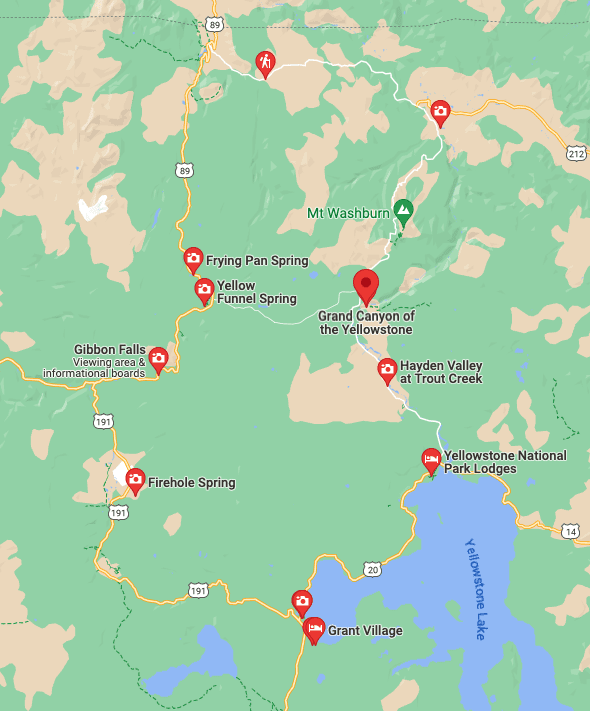
Yellowstone Trip Planner
How Far In Advance Should You Plan A Yellowstone Trip?
This is where you need to start super early planning – and we mean 12 to 13 months in advance. Lodging can be very difficult if you don’t book a room or reserve a campground as soon as they become available.
Yellowstone Trip Planner
How Many Days Are Recommended To Visit Yellowstone?
Visiting Yellowstone National Park can be a great day trip or an extended vacation, depending on your interests. If you plan to explore the park’s main attractions and some of its backcountry trails, it’s recommended that you stay at least three full days. That will give you enough time to visit popular sites like Old Faithful, Mammoth Hot Springs, and the Norris Geyser Basin. You can also take your time exploring the park’s many trails and backcountry areas while taking in the breathtaking scenery of Yellowstone National Park.
For those wanting to explore more of the park’s hidden gems and visit multiple regions, staying for five or more days is recommended. We spent five full days in Yellowstone. That allowed us to experience the various regions of the park, but it still felt like just scratching the surface.
Yellowstone is an immense national park. It can take hours to drive from one part of the park to another. Traffic jams due to animals on the road are common. And if you want to explore or hike in the park, you must devote even more time.
One Day in Yellowstone
While we don’t recommend a single day, you can still take in a few park highlights, even if only one day is possible for your trip.
If you are limited to a single day, you won’t have much time to see the park’s grandeur. For one day, the essential stops include Grand Prismatic Spring, Old Faithful, the Grand Canyon of the Yellowstone, and a drive through Hayden Valley.
A drive over Grand Loop Road will give you a good overview of the park. It can take anywhere from four to eight hours to drive this route. There are many opportunities to pull over on the road to see the incredible sights. Those side stops on the road can lengthen the time of this drive.
Just know there is so much to see in Yellowstone. It is impossible to see everything in a one-day visit.
Top Tip: Be aware that driving through Yellowstone may encounter frequent stops due to animal traffic jams. Bison are famous for making their way on the roads, often slowing or completely blocking traffic in both directions. Plan for such delays when developing your Yellowstone itinerary.
Two Days in Yellowstone
Two days is better than one in Yellowstone. While still not a lot of time to immerse yourself in the park, if you have a second day, we recommend adding a day’s adventure at the Grand Canyon of the Yellowstone and driving through Hayden Valley.
Three or More Days in Yellowstone
Now we’re getting somewhere. If you have extra time for three or more days to add to your itinerary, you can start to sprinkle in visiting some of the highlights mentioned above in our description of the park’s regions. With more time, you’ll guarantee an opportunity to see more of Yellowstone’s best things. Norris Geyser Basin and Grand Prismatic Spring are must stops, in our opinion.
We also recommend taking at least one hike on one of the popular trails.
Yellowstone Trip Planner
Selecting An Airport Near Yellowstone
If you decide to fly from a distant location to reach Yellowstone National Park, you have many choices of airports. Here are the most common airport selections based on the park entrance that suits you.
Bozeman Yellowstone International Airport (BZN) – Located about 90 minutes from Yellowstone’s North Entrance. This is a good option if you want to visit Yellowstone and Glacier National Parks.
Idaho Falls Regional Airport (IDA) – Located about 2.5 hours from the West Entrance. This choice also provides decent access to Grand Teton National Park.
Jackson Hole Airport (JAC) – Located within Grant Teton National Park. This option places you about a one-hour drive to the south entrance of Yellowstone.
Salt Lake City Airport (SLC) – This option is not nearly as close as the other options in this list. However, it’s an excellent choice for people wishing to include Yellowstone in a more extensive Wyoming National Parks road trip.
We selected this airport as it was just over 2.5 hours to Fossil Butte National Monument. From there, we did the ring around Wyoming for all the state’s National Park-related sites. It’s about 5 hours from Salt Lake City International Airport to Yellowstone National Park.
Yellowstone Airport (WYS) – A small airport but only about 10 minutes from the West Entrance
Yellowstone Regional Airport (COD) – Located near Cody, Wyoming – this airport is about one hour from the east entrance. And you’ll be near Cody for all the Western attractions offered in that town.
The smaller airports, such as Yellowstone Airport and Yellowstone Regional Airport, will have limited options from many parts of the country. While the proximity will be easier to reach Yellowstone, the nature of these airports can result in more costly transportation costs.
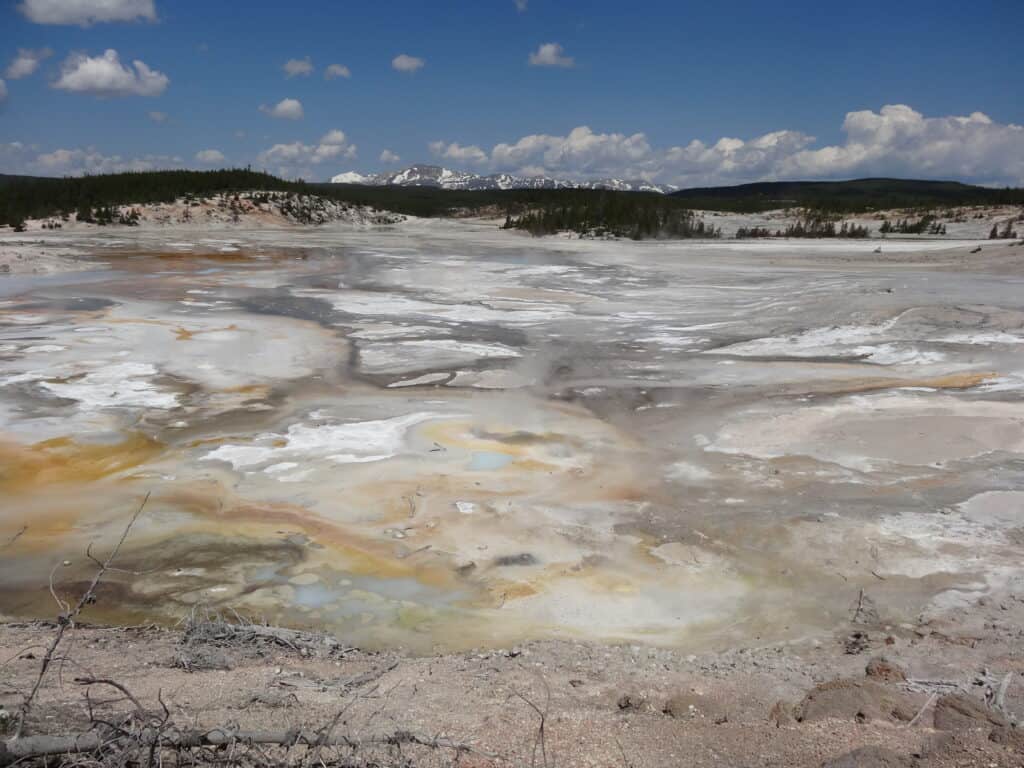
Yellowstone Trip Planner
The Regions of Yellowstone National Park
Deciding how many days to spend in Yellowstone is greatly influenced by what you want to see while visiting the park. We recommend identifying the attractions you want to see. Consult a map for driving times and travel forums such as TripAdvisor for ideas on how long to spend at each site. This will be of great help in personalizing an itinerary that suits you.
If you think your trip to Yellowstone will be a once-in-a-lifetime trip, then make the most of it and visit as many of the regions within the park as you can see.
If you envision future returns to Yellowstone, it can be more feasible to deep dive a particular area.
We split our trip into two days on the West side, two days near Old Faithful, and one on the east.
The park is large. You can enjoy very different experiences as you move from one region of the park to another. Some guidebooks divide Yellowstone into eight distinct areas. For our purposes, we’re identifying five key regions.
West Region
This area, known as Geyser Country, is the most scenic part of the park. Key attractions in the western region include:
- Madison Campground
- Norris Geyser Basin – The largest and most active thermal site. This area has two basins – the Back Basin and Porcelain Basin. You can see Steamboat Geyser, which is the tallest in the world. This attraction is other-worldly, with steaming hot springs and multi-colored thermal pools. Boardwalks in this area let you traverse the topography while staying safe from the geothermal hot spots.
- Grand Prismatic Spring – Plan to visit the breathtaking spring midday when the morning mist is typically burned off the pool. Experience a great view of the spring by taking the 1.6-mile hike on Fairy Falls Trail.
- Old Faithful Geyser – The world’s most renowned geyser is the most popular attraction in Yellowstone. Gather with the crowds on the boardwalk to watch the predictable eruption nearly every 90 minutes. You can also see quite a few other geysers nearby. Visit the nearby Old Faithful Visitor Education Center to learn more about the geothermal nature of Yellowstone.
The road from the town of West Yellowstone to Madison runs through a pleasant valley along the Madison River. The valley floor is a hot spot for seeing wildlife.
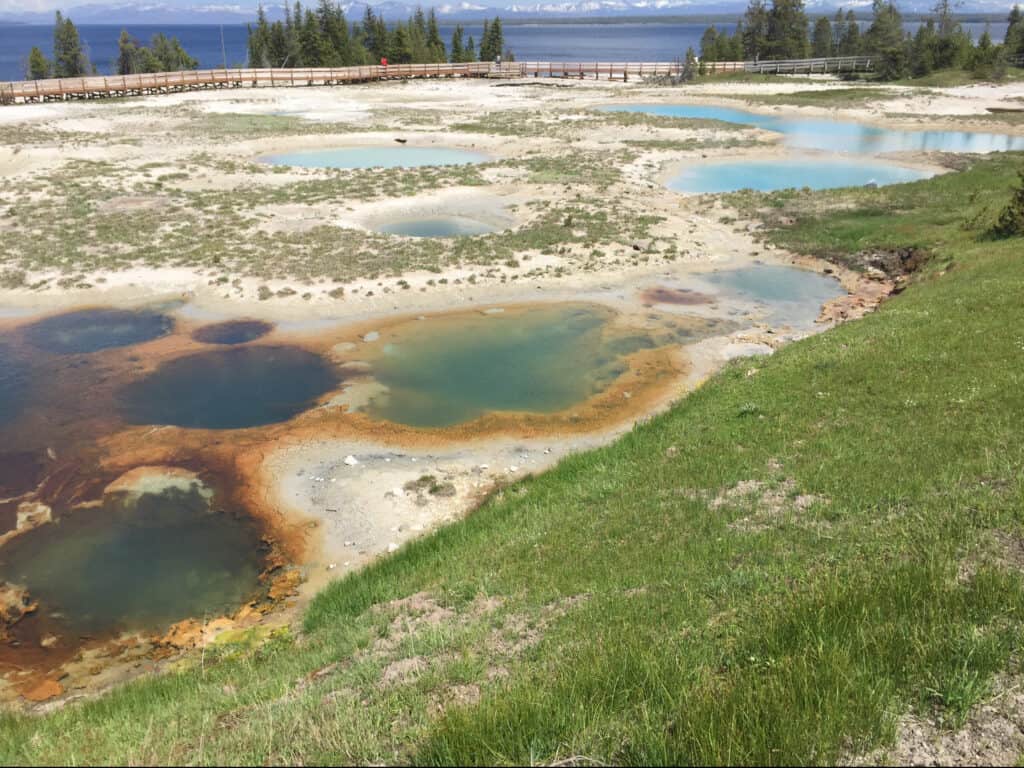
North Region
Mammoth Hot Springs is in the northwest corner. This landscape has many thermal features that feature acidic hot water bubbling up out of the earth’s surface. Travertine terraces are a feature of this landscape. You’ll find plenty of boardwalks in this area for exploration.
It’s also where Fort Yellowstone was and where the army once had an establishment back in the 1890s. You can see where the barracks used to be. It’s an excellent destination for people who want a mix of nature and history.
The 50-mile road to Mammoth Hot Springs is the only road that is typically open all year long. If you are here in winter, it’s a top spot for viewing wolves. You can see Mt. Washburn, the highest peak in Yellowstone, and visit the lower Yellowstone River Canyon.
The Tower-Roosevelt section is in the north part of the park. It is where you can visit and view the 132-foot Tower Falls, Yellowstone River, Roosevelt Lodge, and Lamar Valley. This park section also has the world’s largest collection of petrified trees.
Some call this region the Serengeti of the Yellowstone.
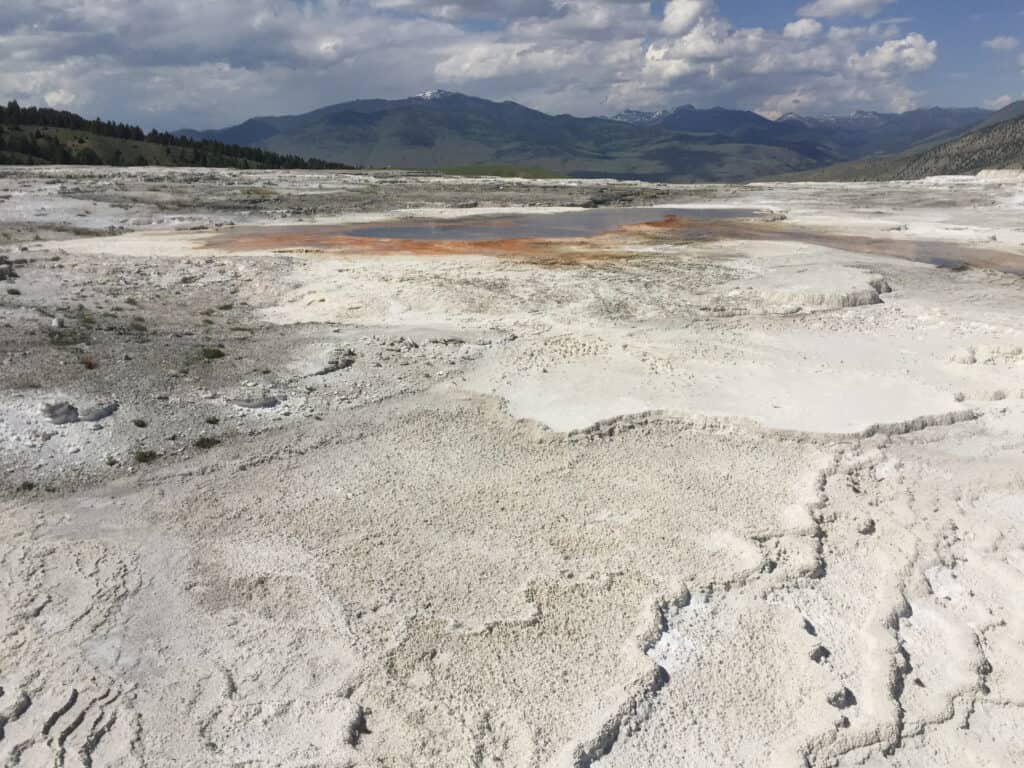
Central Region
Canyon Junction Village is the most popular place to stay in Yellowstone after the Old Faithful area. The Canyon Country region is where you can see some of the largest waterfalls in the park.
The Grand Canyon of the Yellowstone is the main highlight of the central region. You can enjoy views of the canyon from overlooks on the road. The grand terminus is Artist’s Point on the canyon’s east side. Other popular areas to view here are Inspiration Point and the falls.
Lake Village and Fishing Bridge are located on the north shore of Yellowstone Lake.
West Thumb Geyser is another attraction in the central area. You reach it via a short 0.4-mile-long boardwalk that borders Yellowstone Lake. Just south of West Thumb, you’ll reach Grant Village.
Hayden Valley is in the central area. This marshy valley is a beautiful place to view wildlife, including bears, bison, and elk.
East Region
The eastern area perhaps offers the least to see – compared to other parts of the park. So if you have limited time, we suggest emphasizing the different regions of the park and would leave East Yellowstone to people with longer time-frames on their itineraries.
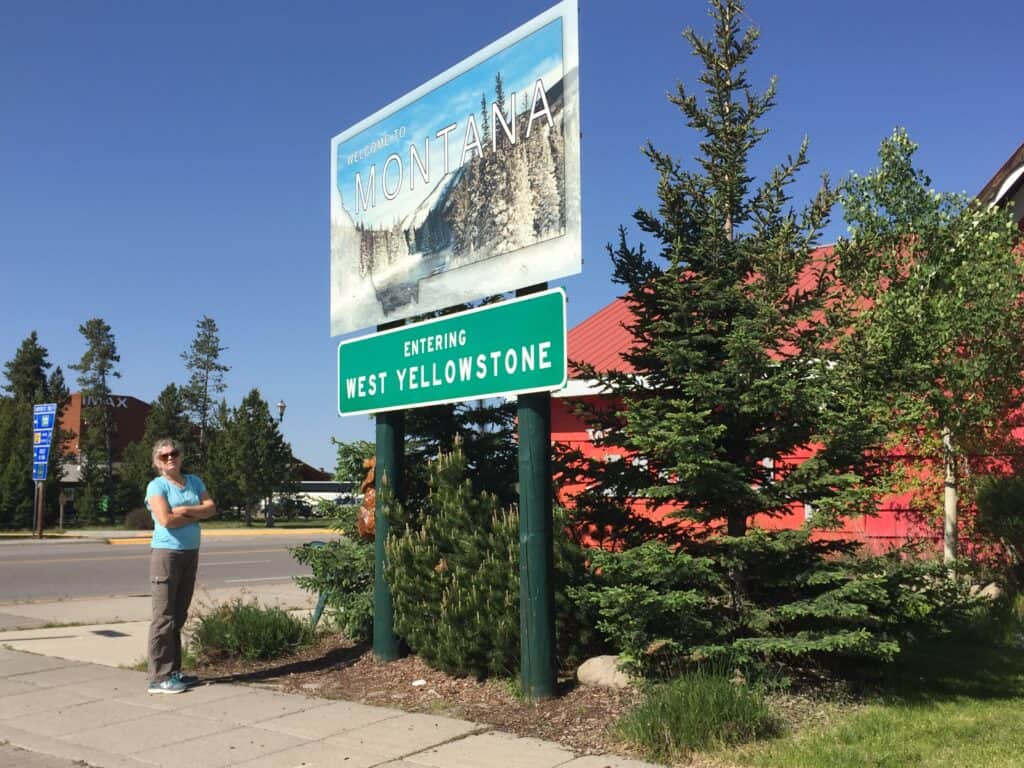
Yellowstone Trip Planner
Selecting Lodging For Your Yellowstone Visit
Inside versus Outside the Park
One of your decisions is whether you will stay inside or outside the park.
Inside the park – much closer to activities and the sights
Cons: Limited food access – have to book super early, expensive
Outside the park – can be less costly. If traveling by RV, you’ll have the flexibility of your own food and your own bed.
Cons: Even outside the park, options can be limited, and you still need to book early
One or More Lodging Locations
Because the park is so large, you might decide to stay in multiple locations. We did this on our 5-day trip to Yellowstone and stayed in three different areas.
The following were our picks for visiting the park.
West Side Glamping Recommendation: Under Canvas West Yellowstone
Our lodging while staying in West Yellowstone was Under Canvas. This unique glamping experience is fitting for a visit to Yellowstone National Park.
Under Canvas West Yellowstone is located just over the border in Montana. We had a two-night stay here and enjoyed it. The beds were comfortable, and the bedding kept us warm. Our bed was a huge king-size bed. There was also a small sitting area in the tent.
It can get freezing here at night. The tents have wood-burning stoves but not all have water or toilets. You won’t find electricity outlets, so you might bring a power station if you drive to this location.
If you book here, take time to know what your specific tent offers. A stay at Under Canvas is like camping, except sleeping here is much more comfortable, and you don’t have to break down camp when done.
You cannot have food in your tent – so you’ll need to pack your snacks in a cooler in your car. Complimentary breakfast is offered at the adjacent dining hall and was enjoyable on both mornings of our visit. The dining room provides good food and is open for breakfast and dinner – though guests are advised to book in advance. You can also order lunch to go if you place an order before 9 pm the following day – then you pick it up the next morning.
There is so much to see and do on the park’s west side – we highly recommend a stay just over the border, and Under Canvas is excellent if you want a glamping type of experience.
Check rates and availability at Under Canvas West Yellowstone
Central Yellowstone Affordable Recommendation: Old Faithful Cabins
The Old Faithful Cabins are steps away from Old Faithful. With the proximity to Old Faithful, it’s easy to get to the geyser early in the morning before the later crowds of the day show up.
These cabins are a budget-friendly option inside Yellowstone. The beds in the cabin were on the soft side. We had some trouble sleeping on this type of mattress. At the time of our visit, no roll-away beds were offered at the lodging places inside Yellowstone National Park.
Electric outlets are limited – you might pack an electrical power bar if you have lots of electronics to charge.
Cooking is prohibited in all accommodations within the park. And there is no TV or air-conditioning, fyi. Internet service is limited, as is cell phone coverage.
Food in the adjacent cafeteria was, well, cafeteria food. You can get a better meal in the nearby Old Faithful Inn.
Check rates and availability at Old Faithful Cabins
Central Yellowstone Iconic Recommendation: Old Faithful Inn
While we didn’t stay at the famous Inn, it is a popular lodging location that deserves mention. Expect to pay a lot more and make your reservations up to one year in advance. The extra cost will reward you with a stay at an iconic inn, where you are steps from the famous Old Faithful Geyser.
If you want to dine for dinner at the Old Faithful Inn or Lake Yellowstone Hotel, – you’ll need to make dinner reservations – and priority is given to hotel guests. You can make dinner reservations up to 60 days in advance.
Throughout the park – breakfast and lunch are served on a first-come, first-seated basis throughout the park.
The lodging near Old Faithful places you as close as you can get to the most popular attractions of Yellowstone, so if you want to be near the highlights, you’ll want to consider this area.
Yellowstone Trip Planner
More lodging options in central Yellowstone
Canyon Lodge and Cabins – Canyon Lodge & Cabins is a quaint collection of lodgings in the heart of Yellowstone National Park. Located just minutes from the spectacular Hayden Valley and Grand Canyon of the Yellowstone, you’ll find cozy cabins and comfortable hotel rooms perfect for your getaway.
Lake Yellowstone Hotel & Cottages – If you’re looking for a special place to stay while exploring Yellowstone National Park, look no further than Lake Yellowstone Hotel & Cottages. Located 30 minutes from the majestic Grand Canyon of the Yellowstone and one hour from Old Faithful, this higher-end hotel overlooks breathtaking views of beautiful Yellowstone Lake. Here, you can enjoy luxurious amenities and services that will make your stay memorable. And, with conveniently located access to some of Yellowstone’s most popular attractions, you’ll surely have an unforgettable visit.
Lake Lodge Cabins – Lake Lodge Cabins offer a more budget-friendly alternative for those staying near Yellowstone Lake. Located just 30 minutes from the spectacular Grand Canyon of the Yellowstone and a short hour’s drive to Old Faithful, these cabins are ideal for exploring what the park offers. Offering all the amenities with no fuss, Lake Lodge Cabins provide an easy and comfortable base to explore the natural beauty of Yellowstone National Park.
Grant Village Lodge – Grant Village Lodge is a waterfront hotel nestled in the stunning landscape of West Thumb Geyser Basin, just 30 minutes away from iconic landmarks such as Old Faithful and the Upper Geyser Basin. With picturesque views of Yellowstone Lake, Grant Village Lodge offers guests an opportunity to explore the great outdoors while relaxing in luxury. Amenities such as a restaurant, pool, and gift shop make it easy to enjoy the beauty of Yellowstone National Park from one convenient location.
Mammoth Hot Springs Hotel – Mammoth Hot Springs Hotel is only one of a couple of lodging options in Yellowstone open during the winter.
Roosevelt Lodge – A great location places you near Yellowstone River with a stay here. Lamar River and Calcite Springs Overlook are also close to the lodging.
Old Faithful Snow Lodge – The Old Faithful Snow Lodge is only one of a couple of lodging options in Yellowstone that are open during the winter.
East Yellowstone Comfort Recommendation: Historic Wapiti Lodge
During our visit to the East section of Yellowstone National Park, we stayed at Historic Wapiti Lodge. This was an excellent lodging option – and our favorite during our visit.
We enjoyed our stay here. Staying in three different lodgings during our Yellowstone trip, this was by far the best. We had a spacious room with a kitchenette, dining seats, and a nice bathroom.
The ceiling fan helped keep the temperature comfortable. Rocking chairs just outside our front door on the porch were great for relaxing. The lodge keepers were very friendly. A convenient little attached shop is stocked with some food and drink options, including wine, beer, and spirits. We enjoyed ice cream in the evening here. Continental breakfast was delivered to our door at 7 am was a nice touch to start our day.
The downside of this location is it is about the furthest away from the main attractions of Yellowstone – but you can explore places off the beaten path.
Check rates and availability at Historic Wapiti Lodge
Yellowstone Trip Planner
When To Book Your Lodging
Reservations typically open on May 1 for the subsequent year. For example, Summer 2024 reservations would open on May 1, 2023. Hotels and lodges usually are fully booked as early as one year in advance. If you miss the initial booking season, you might still get a room as cancellations happen. So check back with your lodging of choice to see if a room opens up.
If you’d like to stay at a campground, please be mindful of the reservation window. Some reservable campgrounds open six months before booking dates.
*** Earn points toward your next vacation with the Chase Sapphire Card
Earn 60,000 bonus points after you spend $4,000 on purchases in the first 3 months from account opening. Click to learn about the current promotion offered by Chase.
Yellowstone Trip Planner
Camping Locations
Campers can consider the following campgrounds in Yellowstone:
- Bridge Bay Campground – located near Lake Village. This campground is close to Yellowstone Lake and West Thumb Geyser Basin.
- Canyon Campground – located in Canyon Village. This campground is near the Grand Canyon of the Yellowstone and Hayden Valley.
- Fishing Bridge RV Park – located near Lake Village. This campground is close to Yellowstone Lake and West Thumb Geyser Basin.
- Grant Village Campground – located in Grant Village. This campground is close to Yellowstone Lake, West Thumb Geyser Basin, and the South Entrance.
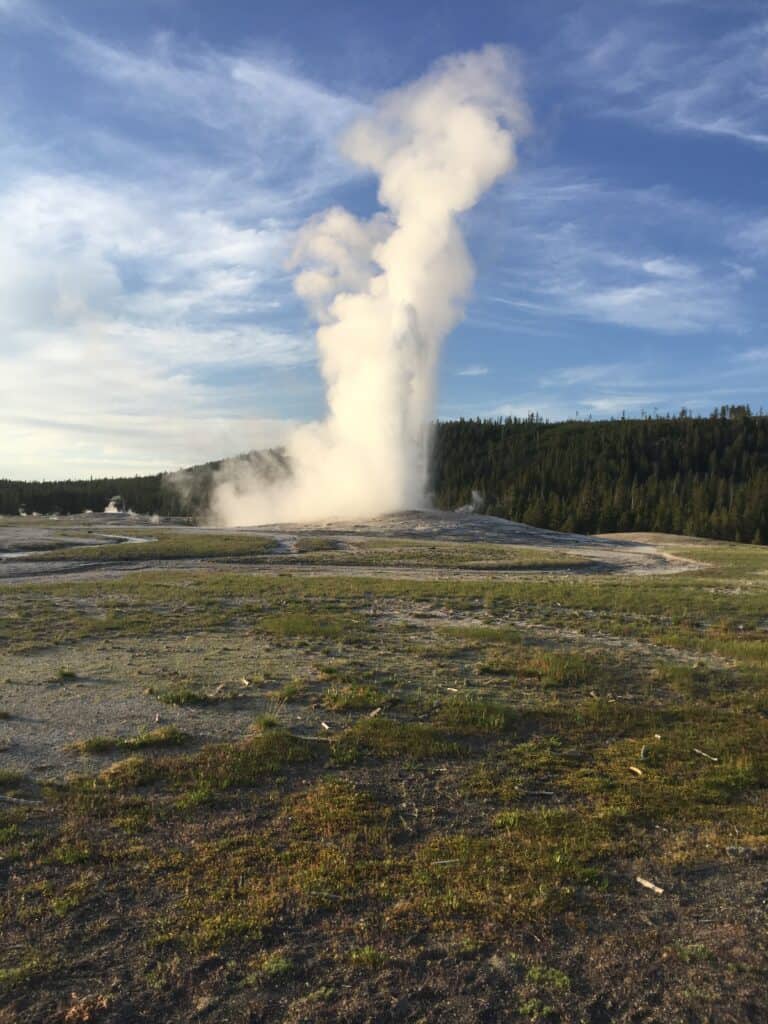
Yellowstone Trip Planner
12 Highlights in Yellowstone National Park
Incredible attractions are waiting for you in Yellowstone National Park. Any visit to the park should also include a stop at one of several visitor centers in Yellowstone. Rangers of the National Park Service in Yellowstone can provide information on current conditions and recommendations to suit your visit.
Below, we’ve curated some of the best places in the park.
1. Grand Loop Road
This iconic road takes you through the park and is a great way to see many fantastic sights. It traverses the park and lets visitors see some of its most spectacular sights. The route will take you to Hayden Valley and Yellowstone Lake in the north and famous geysers as your travel south, including Old Faithful and Norris Geyser Basin. And along the way, there is much opportunity to view wildlife in their natural habitats.
2. Mammoth Hot Springs
Mammoth Hot Springs is one of the most remarkable sights in Yellowstone National Park. Its fascinating geothermal features include terraces of travertine and hot springs that shift in color from yellow to orange to grey. Its bubbling pools and steamy fumaroles create a mesmerizing vista for visitors to enjoy. A boardwalk allows visitors to explore this magnificent natural wonder up close.
3. Lamar Valley
The Lamar Valley and the Lamar River are the place in Yellowstone that bears the nickname of America’s Serengeti.
The large landscape is home to populations of large animals, including wolf packs, herds of bison, pronghorn, grizzly bears, badgers, and overhead – bald eagles and osprey.
You can pull over in the many turnouts on the road and keep your eyes open for wildlife in the valley. Please always be sure to keep a safe distance from wildlife.
4. Hayden Valley
Hayden Valley is one of the most awe-inspiring locations in Yellowstone National Park. Centrally located in Yellowstone, this is the place to visit if you want to see wildlife from the comfort of your car. This stunning valley is home to bison, elk, grizzly bears, and various other wildlife species. It’s also the perfect spot to catch glimpses of Yellowstone Lake.
There are several turnouts on the road where you can pull over and admire the beauty while your car is stopped. Yellowstone River is east of the roadway, and you can enjoy several panoramic scenic overlooks of the valley floor.
This is where you’ll experience breathtaking views as you keep your eyes peeled for some of Yellowstone’s iconic animals. Be sure to bring your camera, as you’ll want to capture this unique and unforgettable experience!
5. Yellowstone Lake
Surrounded by stunning mountain views and lush forests, Yellowstone Lake is one of the most beautiful destinations in Yellowstone National Park. It’s a place where you can take a peaceful stroll around the lake’s edge and observe its serene beauty.
Situated at 7,733 feet above sea level, this lake is the largest high-elevation lake in North America. It’s roughly 20 miles long and 14 miles wide and offers 141 miles of shoreline.
The water here freezes completely, usually in late December, and thaws towards the end of May. It’s a frigid lake year round with average water temperatures around 41°F. Because of this, swimming is not recommended as survival time in such water temperature is estimated at around 20 to 30 minutes.
Birdwatchers will want to keep their eyes open for geese, ducks, ospreys, and other waterfowl dotting the shoreline. Yellowstone Lake holds the largest population of wild cutthroat trout in North America. And it’s a puzzle to scientists to figure out how a Pacific Ocean fish became trapped in this lake which drains to the Atlantic Ocean. The current thinking is that a long time ago, this lake did drain to the Pacific via the Snake River, and fish made their way across the Continental Divide at Two Ocean Pass.
6. Upper Geyser Basin
Upper Geyser Basin is a spectacular sight. Here, you’ll find an abundance of geysers and hot springs spewing steamy water into the air.
It’s home to the ever-famous sight of Old Faithful that erupts every hour or so.
Stroll along boardwalks that take you through various geothermal features and take in stunning views. We found this area to be an other-worldly experience. It’s a place to bring your camera as it is unlike anything we have ever experienced.
Be prepared to walk around the various basins and geysers and experience the diversity of these gems.
Five of the largest geysers are predicted by the Park Rangers. All these geysers, Castle, Daisy, Grand, Old Faithful, and Riverside, are worth seeing, but if you can only see one, try to see Grand Geyser. It’s the tallest predictable geyser in the world, erupting with a 150-200-foot spray every four to eight hours.
7. Old Faithful
The Old Faithful Geyser is often the first attraction that comes to mind when people think of Yellowstone. A feature that makes this particular geyser so famous is its historic punctuality. This predictable geyser erupts roughly every 92 minutes.
We watched Old Faithful put on its show at least four times during our visit. Early morning has the least amount of people. Later in the day, crowd sizes surrounding the geyser grow pretty large.
You can get a viewing spot on the bleachers that surround the geyser. It’s a safe way to watch one of the most violent events in nature – where the ejected water reaches nearly 200 degrees Fahrenheit, and the steam can be up to 350 degrees. When it erupts, a giant stream of water shoots up into the air reaching heights of up to 190 feet.
Enjoy it with your eyes versus being glued to your smartphone or camera.
It is a spectacular experience. Enhance your visit by walking to the visitors center to soak up more background about the geyser.
Some people roll into Yellowstone on tour buses, stop at the lodge, see Old Faithful, have a bite to eat, and are on their way out of the park.
8. Old Faithful Inn
This is a spectacular historic inn with amazing log construction. There are tours offered several times a day. Even if you are staying elsewhere, it is worth stopping by to take in the architecture and history.
You can grab a coffee or sip a libation on the second floor and then relax on the 1st, 2nd, or 3rd floors surrounding the lobby area.
Though reservations are needed, your best local dinner option is likely at this inn. If you don’t have reservations, get your name on the waiting list promptly at 430pm, and you’ll have a chance of getting in at a decent time. We did so on a Sunday evening and were seated at 6 pm. Good service. Wines by the glass and bottle and a few half-bottle selections.
9. Norris Geyser Basin
Norris Geyser Basin is a spectacular other worldly experience. It’s one of the park’s largest thermal basins and one of the most volatile.
Boardwalks and dirt paths let you navigate the area on fit. This basin is divided into two main sections, each with unique features:
Porcelain Basin is the smaller of the two and can be a bit more tricky to navigate. It’s not a path where you would want to bring a child’s stroller, for example. This basin spreads out with a fantastic quilt of natural hues – from azure blues and emerald greens to sulfur-yellow and iron oxide orange – there is much for the eyes to see here. This basin has geysers, hot springs, fumaroles, and vents.
The Back Basin area spreads out over forest and creek sections. It is home to the most acidic geyser in the park.
Bring your camera. It’s unlike anything on earth. Be prepared to walk around the various basins and geysers and experience the diversity of these gems. We spent at least two hours exploring here.
10. Grand Prismatic Spring
Grand Prismatic is the largest hot spring in the United States and is famous for its unique colors. The central blue pool is surrounded by rings of color that range from red to green.
Being here is like stepping onto another planet. This spring is spectacular in size and color. It can get breezy here, and if you lose your hat in the wind, you’ll likely not get it back.
It’s a fantastic place for photography. Boardwalks surrounding the spring and nearby thermal features let you walk around this area’s various pools and springs. You can get a good view of Grand Prismatic Springs from an overlook surrounding the pool.
The color effect is caused by pigmented bacteria and microbes that can survive the warm, mineral-rich waters. And depending on which bacteria are thriving best at a particular time of year influences the colors you see. People who have tabulated the colors count at least 72 shades of color that can be seen in the pool.
The middle of the pool is where water boils up from the underground so that part of the pool is sterile and has a bold blue color.
You’ll find Grand Prismatic Spring a bit north up the road from Old Faithful at the Midway Geyser Parking area. Parking is minimal, so plan for an early start to get to top attractions like this one.
11. Lower Yellowstone River Falls
The Lower Falls are the most famous and biggest of all the waterfalls in Yellowstone. Located in the northern section of Yellowstone National Park, this stunning 308-foot waterfall is said to be the second most photographed spot in the park.
The attraction boasts panoramic views of the river and dramatic waterfalls cascading down from two distinct levels. Popular viewpoints here are Inspiration Point, Grandview Point, and Lookout Point from the east.
And on the west, Artist Point is your key stop. This marquee canyon overlook gives a unique perspective of the famous waterfall.
Most key lookout spots require just a short walk to get a good view of the falls. You can hike up to the top of the falls on a ¾-mile roundtrip trail for a breath-taking vew.
In an impressive display of power and beauty, you’ll see turbulent waters rush over rocks and boulders. It is estimated that between 5,000 and 60,000 gallons of water rush over Lower Falls every second, depending on the year’s season.
12. Grand Canyon of the Yellowstone
The Grand Canyon of the Yellowstone is the main highlight of the central region. This canyon has been carved out over millions of years by the Yellowstone Rivers. It is about 24 miles long and, at its deepest point, descends nearly 1200 feet.
You’ll find two of the three major waterfalls of the Yellowstone River in this section. And there are various things to see depending on the vantage point you select.
From the North Rim – the key sights are Brink of the Lower Falls, Grand View, Inspiration Point, Lookout Point, and Red Rock Point. You can also hike on the Seven Mile Hole Trail from the North Rim section.
From the South Rim – the key sights are Artist Point, Sunset Point, Uncle Tom’s Trail, and Upper Falls View.
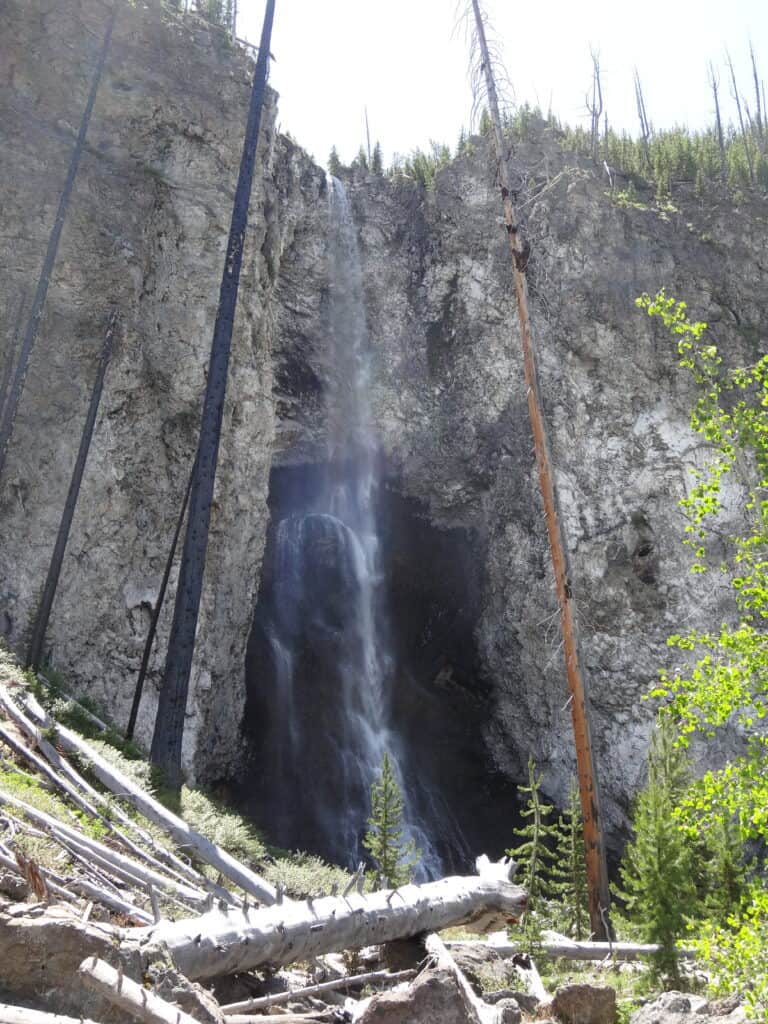
Yellowstone Trip Planner
Hiking Highlights in Yellowstone
Fairy Falls (Easy)
The trailhead is a 5-minute drive south of Fountain Paint Pots. The parking lot is just south of Midway Geyser Basin. Parking is limited. This is a 5-mile round trip hike on the short side, or you can take an 8-mile route. It is bear country, so you’ll want your bear spray. Fairy Falls is a 200-foot-high waterfall and one of the most spectacular in Yellowstone. The hike takes you through a young lodgepole pine forest and, ultimately, to the falls. You can continue a bit further to reach Spray and Imperial Geysers from the trail – if you’re willing to go another 1.2 miles.
Lone Star Geyser Trail (Easy)
This trail is nearby Old Faithful. It is a 4.8-mile out-and-back trail that is partly paved.
Delacy Creek Trail (Moderate)
Another hike we took was the Delacy Creek Trail Hike. During our June visit, a narrow trail took us through a green forest with still patches of snow. We had our eyes open, and ears perked for bear. There were beautiful wildflowers alongside an open meadow. This was an experience we had mainly to ourselves – passing by maybe two other sets of hikers in the several hours we were on this hike.
This hike culminates at Shoshone Lake, the largest backcountry lake in Yellowstone. During the hike, you can watch for sandhill cranes, moose near the lakeshore, and water birds near the lake. Nice and peaceful and a place where you’ll likely have some solitude from crowds.
Plan 3-5 hours for the Delacy Creek Trail hike.
Yellowstone Trip Planner
What To Pack For A Yellowstone Trip
- Camera
- Binoculars – a popular option Bushnell Trophy Roof Binoculars
- Day Pack
- Clothing – pack lots of layers
- Gloves
- Hat, including an option to keep your head warm
- Hiking Boots and wool socks
- Have options to keep you warm – layers and jacket
- Mosquito repellent
- Sunglasses
- Packable cooler bag
- First aid kit
- Water bottle
- Battery packs for your electronics and high speed chargers
Bear Spray – Yellowstone National Park is home to grizzly bears. Especially if you plan hiking, you should always have bear spray. You can’t pack bear spray on an airplane flight, even if you put it in a checked bag.
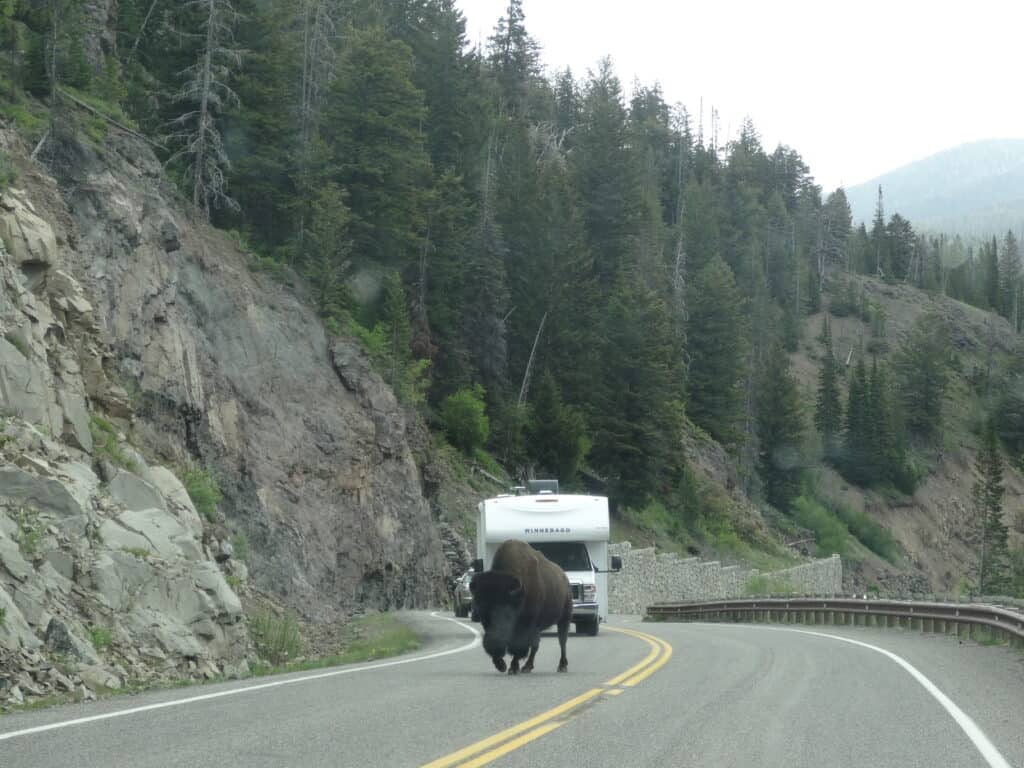
Yellowstone Trip Planner
Driving to Yellowstone
If you fly into the Wyoming area, you’ll want to book a rental car to explore this vast landscape.
Yellowstone National Park offers an extensive road network that lets tourists visit many major attractions by vehicle. The roads are generally open between late April and early November. However, not all roads open at the same time. The only road typically open year-round to vehicles is from the North Entrance at Gardiner, through the park, and continues to Cooke City, Montana.
Here are some approximate driving times from popular places near Yellowstone to plan your driving time.
Idaho Cities
- Boise, ID – 6 hours to West Entrance
- Idaho Falls, ID – 2 hours to West Entrance
- Twin Falls, ID – 4 hours to West Entrance
Montana Cities
- Billings, MT – 3 hours to North or Northeast Entrance
- Bozeman, MT – 1.5 hours to North Entrance
Utah Cities
- Salt Lake City, UT – 5 hours to West Entrance
Wyoming Cities
- Casper, WY – 5 hours to East or South Entrances
- Cody, WY – 1.5 hours to East Entrance
- Jackson, WY – 1 hour to the South Entrance
Check Road Conditions Before Your Trip
Weather and road conditions constantly change in Yellowstone. Check the Yellowstone National Park conditions website to stay up-to-date with the latest conditions.
Yellowstone Trip Planner
See Yellowstone With A Tour
Yellowstone National Park – Full-Day Lower Loop Tour from Jackson Hole
Take the opportunity to explore one of America’s gems: Yellowstone National Park. On this full-day tour from Jackson Hole, you’ll have the chance to spot some of the park’s more famous inhabitants, such as grizzly bears, bison, elk, moose, eagles, and wolves, through binoculars provided by your guide. Marvel at the sights of the Grand Canyon Waterfalls, Grand Prismatic Spring, and Old Faithful, which you can easily explore as park entry fees, breakfast, lunch, and round-trip transportation from Jackson Hole hotels are all included in this package.
Book Yellowstone National Park – Full-Day Lower Loop Tour from Jackson Hole
Rated 5 stars on Viator
Grand Canyon of the Yellowstone Rim and Loop Hike with Lunch
Take a tour of Yellowstone National Park with an experienced guide who will show you the best of the area. From Ribbon Lake to Clear Lake, explore the natural wonders, including geysers and meadows with stunning views of Hayden Valley. This 6-hour tour includes lunch, snacks, and all necessary gear so you can relax and enjoy the journey.
Book Grand Canyon of the Yellowstone Rim and Loop Hike with Lunch
Rated 5 stars on Viator
Yellowstone River Whitewater Rafting
Embark on a thrilling and unique tour of Yellowstone National Park with an adventurous rafting trip! Whether you’re a beginner or experienced, this 8-mile (13 km) river section offers something for everyone. Enjoy the mix of rapids and flat areas as you paddle through breathtaking scenery. Take a break for a refreshing swim along the way and make memories to last a lifetime. Get ready for an unforgettable 3 hours of family-friendly fun on this Yellowstone tour!
Book Yellowstone River Whitewater Rafting Tour
Rated 5 stars on Viator
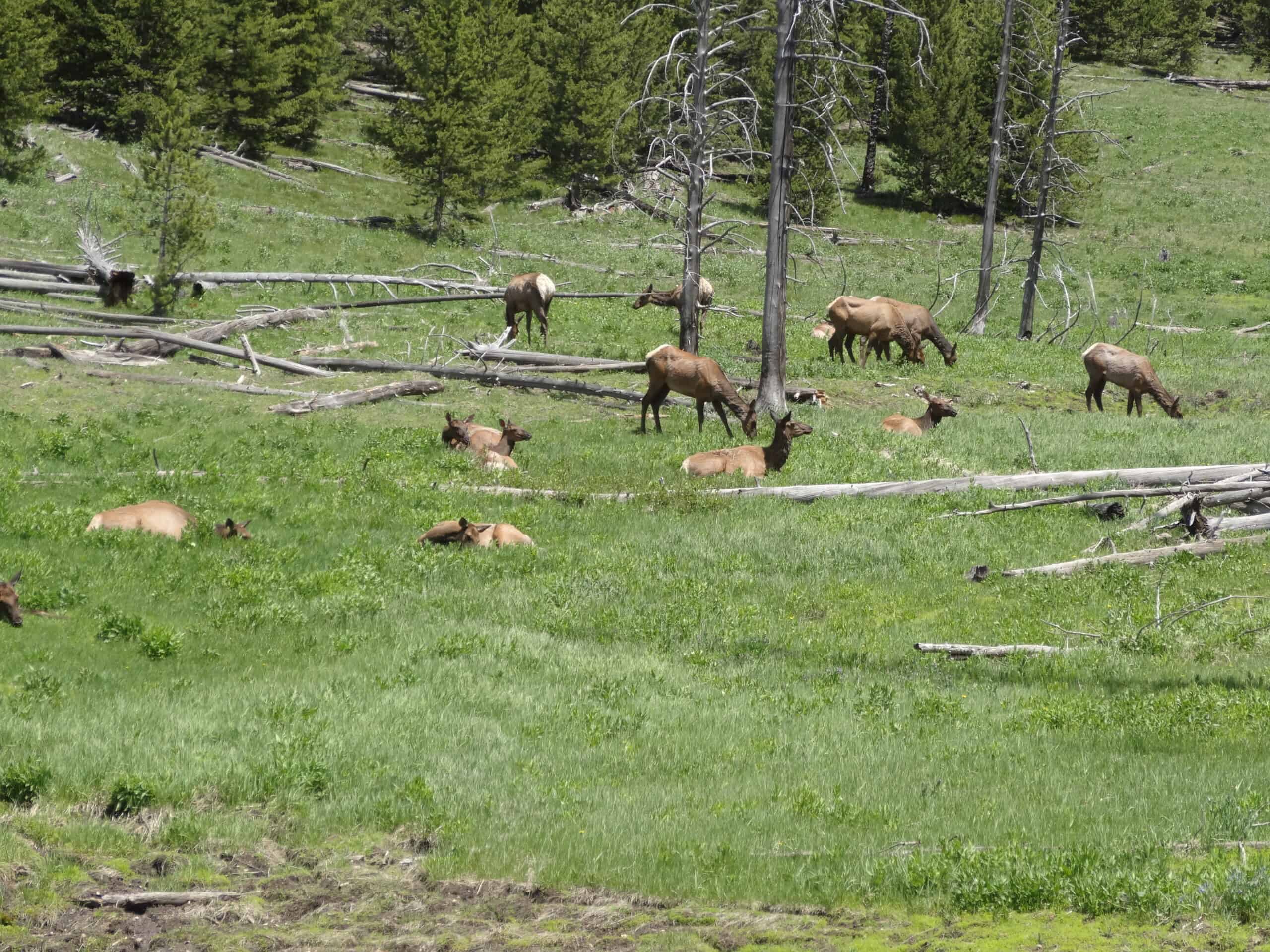
Yellowstone Trip Planner
Frequently Asked Questions – FAQ
Cell phone service in Yellowstone is limited. We recommend that you download information in advance that you would otherwise plan to pull up on your mobile device. This includes information about reservations and confirmations for any activities and lodging and offline maps.
If you want to see the top highlights in both national parks, we recommend a minimum of 5 days and ideally 7 to 8 days. The more days you can make available for a multi-national park trip, the more you can see and experience.
Yes, absolutely! In fact, a large portion of Yellowstone National Park sits within the caldera of an ancient supervolcano. Parts of its crater rim form some of the park’s mountains, and lava last flowed on the surface as recently as 70,000 years ago. The Yellowstone Volcano first erupted about 2.1 million years ago, with its last major eruption occurring 631,000 years ago. But that doesn’t mean it’s inactive – smaller eruptions have occurred ever since, some big enough to form prominent features such as the West Thumb of Yellowstone Lake. This proves that while the Yellowstone Volcano may be dormant now, it’s far from dead!
The average price of a 7-day trip to Yellowstone National Park is over $1,600 for a solo traveler. Plan on an average of nearly $3,000 for two people and $5600 for a family of 4. Your costs will vary based on the type of lodging selected and dining choices. Plus, consider the cost of fuel if driving from your home to Yellowstone.
Decide on these essential factors: When you will go, number of days for your trip, lodging, transportation (fly or drive), tours, or DIY travel.
Cars are the best way to travel if you are planning a summer road trip around Yellowstone. The Grand Loop Road will take 4-7 hours to complete, so plan enough time for your journey! If you don’t have access to a car, there are bus tours and concessionaires that can provide transportation services.
Yellowstone Trip Planner
Yellowstone National Park – Know before you go
✈️ Closest Airport: West Yellowstone Airport (WYS)
⏰ Time Zone: Mountain Daylight Time (GMT-6)
Yellowstone Trip Planner
Listen to our podcast – Planning a Trip to Yellowstone
Our episode is available on Spotify, Apple Podcasts, and all major podcast services. Or, you can listen below.
In episode 92, we continue our multi-episode road trip in Wyoming. This installment is about planning a trip to Yellowstone National Park. We’ll visit all of Wyoming’s National Park system sites as we make our way through this series.
In this episode, we explore some key considerations when planning a trip to Yellowstone National Park, including airport choices, lodging considerations, and a high-level view of the various regions inside the park.
Yellowstone is just one of several National Park sites in Wyoming. Our podcast series also covers our trips to Fossil Butte, Grand Teton, Devils Tower, and Fort Laramie. We even cross the border into South Dakota to visit Mount Rushmore on our epic Wyoming road trip.
Lastly, we close with a packing list for your trip.
Yellowstone Planning Tips Discussed on our Podcast Episode
- Airport options
- Regions of the park
- Lodging options inside and outside the park
- Under Canvas in West Yellowstone
- Cabins near Old Faithful
- Historic Wapiti Lodge in East Yellowstone
- Packing tips for a Yellowstone trip
Yellowstone Trip Planner
Plan Your Yellowstone Adventure Today!
Get ready to be amazed by this national park’s incredible geothermal areas, diverse wildlife, and beautiful scenery.
We hope this Yellowstone Trip Planner post inspires you to consider planning a Yellowstone vacation. Which activities will you plan on your trip? Drop us a line if you plan a trip to Yellowstone National Park.
We hope to see you, at the places where we go.
Julie & Art
#yellowstone
Subscribe to our Newsletter
Pin it!

